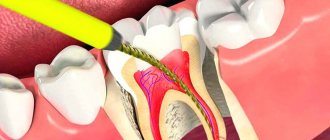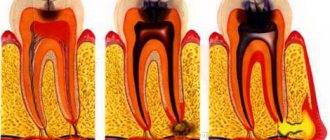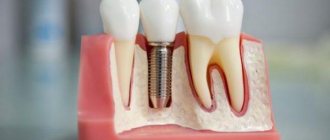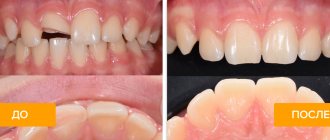Specialists in modern dentistry sometimes carry out such a procedure as replacing a filling. The reasons may be different, for example: a long-established filling (from amalgam, old mixed materials and cements) that needs updating. There are also more serious motives.
The filling serves to restore the original shape of the tooth, use it in the chewing process, and also to prevent its further destruction.
Over time, darkening appears in place of old fillings, indicating the presence of small cracks and further development of caries. At this point, replacing the filling is the best option (despite the fact that the filling may still hold well for some time).
In order to place a new filling, you must first remove the old filling.
The filling is made from different materials, so removal is individual for each option.
Pastes
Almost all types of pastes can be easily removed using a regular solvent. First, using Girdwood burs and long round burs, and then Hedström files or new reamers, the filling is removed. If removal occurs from the canals, then it is necessary to know exactly the length of the tooth, which is done using x-rays. It is also necessary to irrigate the canal frequently to remove any sawdust that appears.
After the filling is removed, it must be replaced with a new one. The most common of them are a light (light-polymer) filling, which is most often installed on the front part of the teeth, a cement filling (zinc phosphate, glass ionomer, zinc eugenol), as well as an inlay.
How long does a filling last?
The minimum service life of a filling is considered to be 3-5 years. Some materials last longer, up to 10 years. Much depends on the condition of the treated tooth after the minimum period.
What affects the service life of the filling:
- how correctly the dentist selected the size and installed the filling;
- the material from which it is made;
- what is the thickness of the walls of the abutment tooth and what condition is it in;
- what hygienic care is required: abrasiveness of pastes, hardness of the brush, use of special products;
- whether the patient has bad habits that have a harmful effect on the filling material;
- how much solid or tough food is in the diet, whether the temperature of food and drinks is moderate, etc.
Sealing
High-quality tooth filling occurs in 40-60 minutes. Root canals are washed using antiseptic agents and filled with sealed material. If the canals have been sealed professionally, then future infection is excluded.
The next step is filling the tooth cavity. The dentist installs the required matrix on it, suitable for the further shape. Then an adhesive (good adhesive) composition is applied and work is done on the future filling. The filling is laid in layers. The final stage involves adjusting the filling to the bite and polishing it.
In order to avoid replacing fillings, you need to carefully monitor your dental hygiene and visit the dentist as often as possible.
When to refill
The following conditions indicate the need to replace the filling:
- Pain in a filled tooth.
- Crown destruction.
- The appearance of caries on a tooth.
- Constant unpleasant taste in the mouth.
- Deterioration of restoration aesthetics.
- The seal has expired.
If you notice such signs, you should contact your dentist so that during an examination, a specialist can determine the cause and prescribe a procedure to replace the filling and re-treat the tooth.
In addition, a new filling should be installed in the following situations:
- The color of the filling has changed (yellowness, darkening has appeared). This indicates the beginning of the destructive process in the tooth. If the filling turns red, it will most likely require not only a refill, but also cleaning of the dental canals and intra-canal bleaching.
- Abrasion of the seal. The relief of the filling changes, the distribution of the chewing load is disrupted. Changes occur in the bite, digestive disturbances, and problems with the TMJ may occur.
- Overhanging filling. Food debris accumulates in hard-to-reach areas, inflammation appears in soft tissues, gums bleed, and caries develops.
- Compaction of the filling. The material begins to pull the tooth tissue along with it, cracks and chips appear, and inflammatory processes develop.
- Flat filling surface. A competent dentist forms fissures and bumps on the surface of the filling material, which correctly distribute the chewing load. If this is neglected, contact with the opposite teeth of the other jaw is disrupted, and the bite becomes incorrect.
- Appearance of roughness. Indicates the formation of pores and microcracks, therefore, the tightness is broken and there is a risk of caries formation. Not only the fact of installing the seal is important, but also proper grinding and polishing.
How does the replacement work?
Let us note right away that the procedure is carried out under local anesthesia and discomfort is minimized due to this.
In general, replacing a filling is carried out as follows:
- anesthesia is administered;
- the desired tooth is isolated from the rest by a rubber dam in order to protect them from pathogenic microorganisms;
- the old filling is removed, the tissues are cleaned of caries if necessary;
- the cavity is treated with drugs and dried;
- make an insulating or medicinal pad;
- a new filling is installed.
If we are talking about restoration, then it is carried out taking into account all the anatomical features of the chewing surface.
Remember that regular preventive examinations help to identify pathologies and defects in a timely manner. Agree, it is better to spend a few minutes polishing the filling than to replace it globally after some time. This will not only save you money, but also keep your teeth and nerves healthy.
Causes of an incorrectly installed seal
After treating a tooth, the dentist must install a filling that will protect and isolate sensitive tissues from bacteria and microbes entering the resulting cavity.
The filling material undergoes a polymerization process and then must be properly sanded. At this stage, the doctor monitors and corrects its fit to the tooth, as well as its position relative to the gums, cheeks, and tongue.
The most common causes of toothache after a filling is installed are:
- Oversized filling.
- The solution has shrunk.
- The treatment procedure was carried out in violation.
- Inflammatory began in the canals.
- Poor quality filling material.
- Allergy.
- Incorrect diagnosis and, accordingly, treatment.
- There was an infection in the dental canals.
Let's find out why a tooth hurts after a temporary filling
To control the protruding edges of the filling material, its position relative to the rest of the teeth and the bite, the dentist uses a special coloring strip. The test is that the patient must bite it several times. If the doctor sees that there are no obstacles, then he begins polishing.
This is a very important stage, because if you make a mistake and do not notice the protruding edges of the filling, they will cause problems with chewing food and oral hygiene, which will lead to the development of negative consequences and various diseases.
Doctor's actions
The dentist must act and take measures based on the reasons that led to discomfort after dental treatment. There may be several situations:
- The discomfort does not go away within several days. You should definitely visit a doctor who will polish the filling in a couple of minutes. Otherwise, negative consequences may begin to develop and tooth decay may occur.
- If the edges of the filling are too sharp, they can cause injury to the gums, tongue or cheek. In this case, you should immediately visit the dentist so that he can immediately polish the filling, thereby preventing possible injuries.
- A crack remains between the filling and the surface of the tooth. You should definitely see a doctor again, as bacteria and microbes will get into the gap that has formed, which will trigger the development of caries.
Also, do not ask the doctor to file down the filling too much. The teeth of the upper and lower jaws must be in close contact with each other while chewing food. If this does not happen, then the person’s bite will be disrupted.
What to do
There are several ways that a new filling can cause discomfort. Among them:
- Wrong size. It may be too big or small for the tooth.
- Poorly installed and polished filling. The filling material protrudes from one side of the tooth, causing additional discomfort.
Any of these problems can lead to further tooth decay. It is better not to try to correct the situation on your own, but if you notice the first symptoms, immediately contact your dentist.
The doctor must properly sand the filling material. The adjustment will take a maximum of 5-10 minutes.
Some people are in no hurry to seek help from a specialist because they mistakenly believe that the filling itself will wear off over time and stop causing discomfort. But the modern material that dentists use is more durable. A high-quality filling will shrink and begin to wear off only after a few years.
Possible consequences
If the dentist installed the filling incorrectly, and the patient is afraid or does not want to go back to fix this problem, then there is a high probability of negative consequences developing. These include:
- Pulpitis and periodontitis. They are the result of an over-inflated filling. That is, there is constant and strong pressure on the tooth, which leads to chronic injury. Because of this, the enamel on a person’s teeth wears off, which leads to the re-formation of caries. If the filling is not corrected in a timely manner, the tooth will have to be depulped.
- Chipped tooth surface. It also occurs due to constant pressure on the tooth that has been filled.
- Dislocation. It can happen if, when closing the mouth, the teeth close unevenly and incorrectly on different sides. In other words, a misalignment occurs and pathology of the temporomandibular joints develops. The main signs of this problem are: pain, crunching, clicking.
After the treatment, it is very important how the dentist filled the tooth. If the filling begins to interfere with the motor functions of the lower jaw, then it is worth telling the doctor about this so that he can polish it again.
It’s easy to check if the filling is in the way. You just need to move your lower jaw to the right, left, forward, and also leave your mouth open. If you feel pain or discomfort, you should immediately inform your dentist so that he can fix the problem.
People who do not want to go for a second appointment mistakenly believe that over time the filling will wear off and stop causing discomfort. Of course, a feeling of addiction may arise, but it will not in any way affect the solution to the problem. You cannot do without the help of a dentist.
The sooner you re-visit the doctor and adjust the filling, the lower the risk of developing negative consequences and dental diseases.
Reasons for changes in bite after installation of a filling
There are several factors that provoke changes in the bite after a filling:
- excess filling material, which provokes overestimation of the tooth and unclear formation of its working surface;
- lowering of the tooth due to too intense grinding;
- progressive periodontitis, causing mobility of treated teeth;
- displacement of adjacent teeth after extraction and filling;
- absence of a layer between the filling material and the pulp - when chewing, the dental nerve is constantly irritated and a deceptive sensation of a filling defect is created.
What to do when a filling falls out
Further treatment tactics depend on the patient’s behavior after the temporary filling falls out. If you do not take any action and wait for your appointment, then most likely the doctor will have to re-clean the tooth cavity or even carry out additional procedures to eliminate pathological processes that have arisen due to external factors. An open tooth is accessible to all infections and is highly undesirable at any stage of treatment.
If the filling falls out on the day of installation
In cases where the temporary filling falls out after 2 hours or approximately this time, you must immediately contact a specialist for re-filling.
What should you do if a temporary filling falls out in the evening, when you can no longer visit the dentist? In such a situation, it is necessary to close the cavity. For this, for example, you can purchase a special dentin paste or its analogues at the pharmacy. You should try to remove the remains of the filling, but without using sharp objects, so as not to damage the internal tissues and channels. After this, the cavity is filled with paste, and the next day they are sent to the attending physician.
If it is not possible to purchase such a paste, it is recommended to minimize food intake and constantly rinse your mouth with mouthwash or other antiseptic agents. Rinsing is necessary after each meal to flush out food particles from the exposed tooth that may get into the cavity.
Loss of filling in sealed and unsealed canals
The greatest risk occurs when a temporary filling falls out and the canals are not sealed. Due to the high probability of contamination of the dental canals, the patient should also “seal” the tooth with paste, or rinse the tooth regularly. You can also use a soda solution for rinsing. On the same day or the next day, the patient must go to the clinic to take measures to close the cavity in the crown.
If a temporary filling falls out, but the canals are sealed, what should I do? In such patients, the likelihood of complications is minimal, since neither infection nor foreign particles can penetrate into the canals themselves. But it is still impossible to leave the cavity open, since the crown is weakened and its internal tissues are not protected from mechanical stress. Patients are also advised to rinse as a preventative measure and to see a dentist again, who may even install a permanent filling right away.
What to do if the seal on the water meter is broken. Unmetered water consumption
When registering a water meter, a representative of the service company seals it and writes down the seal number in the report (by the way, now many resource supply companies install anti-magnetic seals on the water meter), and also records the current meter readings.
The seal is installed in order to prevent unauthorized persons from interfering with the operation of the device for the purpose of illegal use of water.
But sometimes circumstances develop in such a way that the seal on the water meter was torn off without malicious intent.
What to do next, and will there be a fine for this?
What is considered unaccounted for water use, and what is the punishment for it?
Before moving on to the problem of a broken seal, you need to figure out what is considered unmetered use of water, and what is interference in the operation of the meter or unauthorized consumption.
Unmetered water consumption is the consumption of water in the absence of metering devices (there may be various reasons - the meter is out of order, was never installed).
Illegal water consumption (as well as interference with the operation of the meter) is considered under the following conditions:
- Each subscriber using water must enter into an agreement with the company providing such service. Consumption of water in the absence of such an agreement is an unauthorized connection.
- Unauthorized connection of a home water supply to the central system without the appropriate documentation authorizing these actions is considered illegal.
- Interference with the operation of a water meter is considered to be: the presence of mechanical damage to the water meter, loose fitting of the indicator glass, or violation of the integrity of the seal.
However, not every unmetered water consumption is punishable by large fines: if the meter simply fails for reasons beyond the control of the consumer, then the supplier makes a calculation based on the average consumption of the utility resource over the last 6 months.
In other cases (in case of unauthorized connection, breaking the seal and failure to report this fact, or interfering with the operation of the meter), this is punishable by a fine.
Punishment for illegal use of water
With the rise in prices for utility bills, cases of water theft have become more frequent. Supply companies began to actively fight against unaccounted consumption. If unaccounted use of water is detected, especially during unauthorized connection, the subscriber has the right to take the following actions:
- a representative of the resource supply or management company draws up a report on unauthorized connection to water supply systems or a report on interference with the operation of the metering unit;
- The cost of consumed water is recalculated for the last 3 months or from the date of the last inspection based on the power of unauthorized connected equipment (for unauthorized connection) or based on ten times the water consumption standards.
What does the subscriber face if the seal is accidentally broken?
An ordinary seal in the form of a lead or plastic stamp is hung by the inspector on the meter using a thin wire, fishing line or thread. Sometimes they rot on their own due to dampness. It happens that a person accidentally gets caught on a seal or children can tear it off. There are many options.
The legislation does not provide for a fine for accidentally breaking a seal from a metering station; however, there are some pitfalls. If the subscriber lives in an apartment building where a HOA has been created, the amount of the fine may be separately displayed in the contract. In other cases, the service provider is guided by current legislation.
If the seal was accidentally broken, the subscriber must immediately report the fact of the seal breaking and the current readings at the time of its breaking to the resource supplying organization (HOA or management company).
In this case, failure of the seal will be regarded as a breakdown of the water meter. In accordance with 59 Decree of the Government of the Russian Federation No. 354 of 05/06/2011, the subscriber is allowed to recover the cost of the resource based on the average monthly volume of water consumption during the period of absence of the seal.
If you do not notify the water supplier about the seal being broken, and this fact is revealed during the inspection, then the calculation will be made for cases of interference with the operation of the metering unit - based on ten times the volume.
What to do with an accidentally broken seal so as not to be accused of interfering with the operation of the meter?
To avoid charges of interfering with the operation of the water meter after an accidentally broken seal, you must contact the service provider before repairing your apartment or replacing plumbing. Even if the old water supply is supposed to be replaced, a company representative will document the removal of the seal, as well as the meter, and the whole process will be painless and without consequences.
If a seal accidentally breaks, you should not put the problem on hold and immediately contact the appropriate water meter service organization. This could be a management company, HOA, water utility or other service company.
The most correct way would be to submit a written application in two copies. One of them remains with the subscriber. The application shows the reason and time of the seal failure, and also stipulates the date of arrival of a representative to carry out a new seal. The second copy of the application will be useful to the subscriber if the controller fails to appear on time. The document will not give the right to charge a fee for using water without a meter based on ten times the standard.
If it is impossible to visit the company in person, one copy of the application can be sent by registered mail with mandatory notification of receipt. In any case, a timely submitted application relieves the subscriber of a fine for accidentally breaking the seal. If, after checking the metering unit and payment receipts for previous months of water use, no violations are revealed, the apartment owner will only have to pay for a new sealing of his water meter.
Based on your application, a representative of the resource supply company will easily seal the cold water or hot water meter and the problem will be solved.
Still have questions? Do you want answers to them?
Here you can ask a question free of charge to the experts or lawyers of the gkh-konsultant.ru portal.
Causes
The main reason for the appearance of the symptoms described above is an excess of filling materials and inaccurate formation of the surface of the restored unit. Because of this, the surface of the tooth becomes slightly higher than necessary for proper closure of the jaws.
The qualifications of the specialist who performed the filling procedure are not always the cause of the problem. Often, local anesthesia is used during the installation of fillings, so the patient may not accurately describe his sensations when the specialist asks him to describe the sensations after the final polishing is completed. As a result, after the medication wears off, discomfort appears that was absent when you were in the dentist’s chair.
In some cases, the source of discomfort may be the inflammatory process of the periodontium, due to a violation of the stable position of the dental unit. Almost imperceptible tooth mobility can disable the mechanism of closure of the upper and lower jaw. But before the filling was carried out, the missing part of the unit compensated for the defect. Accordingly, after complete restoration of the size and shape of the tooth, the disease manifests itself in full.
Another cause of discomfort can be tooth misalignment. Often this symptom appears after filling a gap between teeth or removing a unit in the same row. Complaints that the filling is in the way appear several months after installation. The missing unit causes the remaining teeth to shift towards the empty space, so when they are closed tightly, unpleasant sensations appear.
A common cause can also be an excessively thin wall between the pulp chamber and the product. Because of this, the pressure that is applied to the filling during chewing is transferred to the bottom of the chamber and irritates the dental nerve. In such cases, the cause of the unpleasant sensations lies inside the dental unit, but is felt as a structural defect.
Home treatment methods
As mentioned above, it is impossible to get rid of the problem at home, and it is unreasonable to expect natural abrasion of the material.
To alleviate the condition before visiting a specialist, you need to follow certain recommendations:
- Avoid eating hard foods that require biting. The sealed unit, due to its higher location, is subject to the main load, and this is fraught with a fracture of its base.
- Eliminate hot foods from your diet. This is because such foods and drinks can cause swelling of the soft tissues, increasing the discomfort.
- For severe pain, analgesics or non-steroidal anti-inflammatory drugs can be used. However, you should not abuse such drugs, because their use is limited - no more than 5 days.










